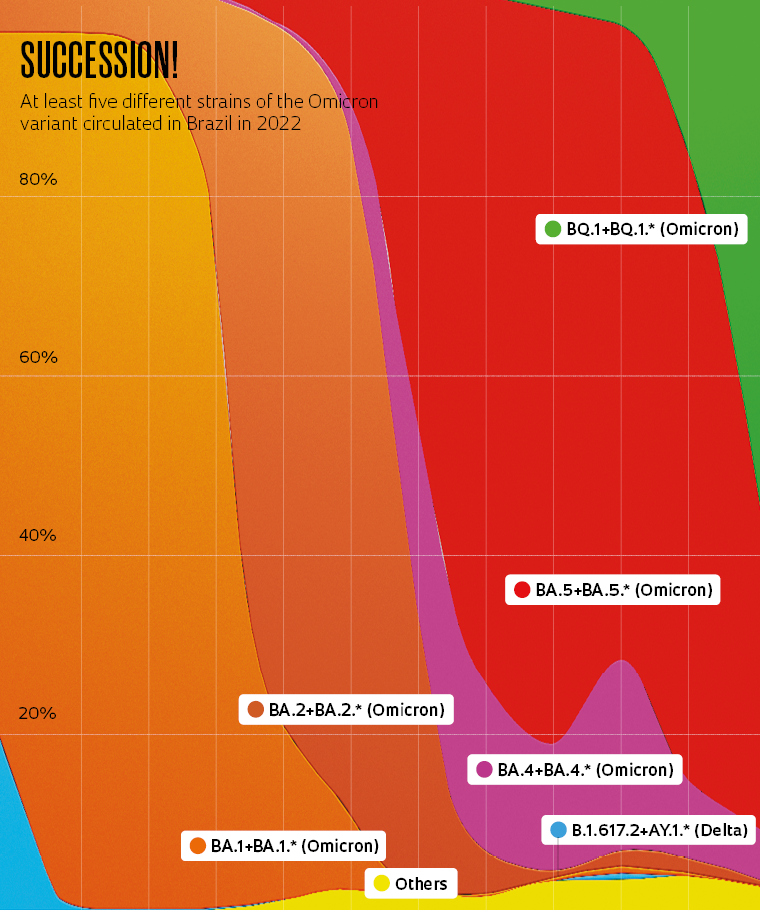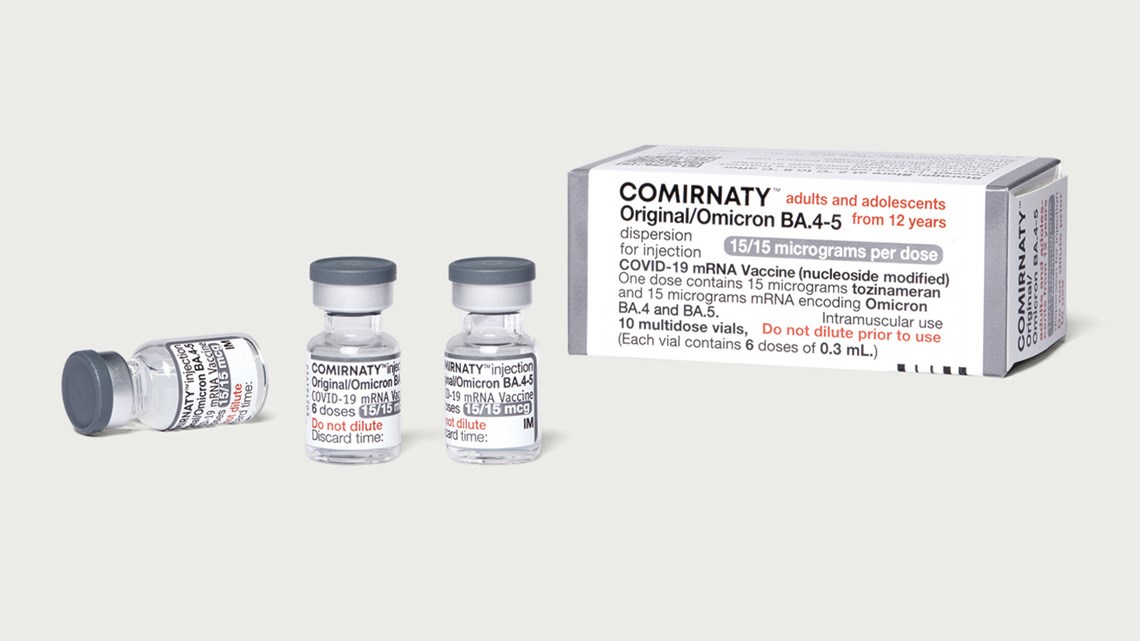When the World Cup began in November, the COVID-19 pandemic seemed to be behind us. Masks had not been mandatory for months and almost no one was wearing them on the street or in enclosed spaces. Seeing groups of friends gathered to watch the games—and to celebrate wins or mourn losses—without worrying about social distancing was commonplace. Despite the impression of a return to normality, however, the number of cases was once again on the rise in the country. The number of SARS-CoV-2 infections averaged 26,304 per week in the first week of November (almost 3,800 per day), the lowest value of the year at that point, before surging to 321,349 in the third week of December (46,000 per day), according to data from Brazil’s Ministry of Health. The 12-fold increase in total cases was accompanied by a more modest increase in the average number of deaths, which grew by 4.6 times in the period, from 251 deaths per week to 1,116. Although far below the worst moments of the pandemic, the figures make it clear that almost three years after it began, the public health crisis is not over yet.
“The pandemic has continually surprised us,” says Paola Resende, a biologist from the Oswaldo Cruz Foundation (FIOCRUZ) in Rio de Janeiro. “There have been multiple times when we thought it was coming to an end and then we were hit by a new wave,” says the researcher, who works at the Respiratory Viruses and Measles Laboratory (LVRS) and participates in the foundation’s Genomic Network, responsible for monitoring the evolution of SARS-CoV-2.
Some experts claim that the official numbers are just the tip of the iceberg. With the spread of rapid tests sold over the counter in pharmacies, it has become more difficult to ascertain the total number of cases, since there is no obligation to report test results to the authorities. Thus, only the most serious cases—those that require treatment at hospitals and health centers—are recorded. But most infections are mild, especially in people who are fully vaccinated, who usually only experience symptoms similar to a cold, with varying degrees of fatigue and malaise. Severe cases are largely restricted to people with other illnesses and elderly people who have not been fully vaccinated as recommended.

“Our monitoring of the situation has been unreliable for a long time,” says virologist Fernando Spilki of Feevale University in Rio Grande do Sul, head of the National COVID-19 Omics Network (Rede Corona-ômica BR), which monitors how the virus is circulating in the country. “We would have more information if, for example, there was a QR code on the box of over-the-counter tests that directed people to a website where they could enter their test results, or if the health system was actively searching for cases. It is important for us to know these things to prevent the spread of the disease,” he explains.
The current wave began to take hold in Brazil a few months after the arrival of a new strain of the virus known as BQ.1, derived from the Omicron variant. This strain, one of more than 300 subvariants of Omicron, seems to more easily evade antibodies produced in response to the vaccine or previous infections with other variants of the novel coronavirus and has already led to an increase in COVID-19 cases in Europe and North America. By sequencing the DNA of virus samples, Fiocruz found that the frequency of cases caused by BQ.1 in Brazil increased by 3.6 times in just one month. The strain accounted for 15.6% of infections in October and 56.8% in November. In the same period, BA.4 and BA.5, two other subvariants of Omicron that were more common in the middle of last year, fell from 8.2% to 5.4% and 70% to 34.1% respectively (see graph).
First identified in South Africa at the end of 2021, Omicron quickly spread across the world and caused at least three major outbreaks in Brazil. The first occurred in early 2022, driven by the spread of the BA.1 subvariant. Although much of the population was already vaccinated at the time, the new strain of the virus caused an explosion in the number of cases. There were 1.3 million new cases recorded in the last week of January (almost 186,000 per day), with the weekly average number of deaths reaching 6,246 in mid-February (see graph). With immunization advancing and BA.1 being overtaken by BA.2 in April, the number of new cases dropped to around 100,000 per week. But after the arrival of BA.5, a second wave of infections began in June, when the weekly average returned to 400,000, remaining at that level until August. The most recent surge began in October with the emergence of BQ.1, derived from the BA.5 strain, which has led to yet another increase in the number of cases.

The strains that have begun circulating in recent months—in particular BA.4, BA.5, and subvariants of the latter, such as BQ.1—carry important mutations in the spike protein, used by the virus to invade cells. These mutations change the shape of certain areas of the protein, making it difficult to recognize for antibodies, whether generated by vaccination or previous infection. “These new strains are leading to people who have already had Covid becoming infected again,” says Resende, from FIOCRUZ. The phenomenon is known as immune escape, where infection can occur even in people who have been fully vaccinated.
“It was initially thought that we might achieve herd immunity through vaccination and infections, but the virus has evolved so quickly that these strategies are not fully protecting us against the variants in circulation today,” reports infectious disease specialist Julio Croda of the Federal University of Mato Grosso do Sul (UFMS) and FIOCRUZ.
Luckily, the coronavirus’s immune escape is only partial. The new strains of SARS-CoV-2 are capable of evading the so-called neutralizing antibodies, which are responsible for stopping the virus from entering cells and even preventing asymptomatic and mild infections. The immune system has other tools, however, meaning new strains still have to deal with non-neutralizing antibodies, which adhere to the virus or the surface of infected cells and alert the immune system of the presence of the invader, triggering a cellular response. With more comprehensive powers than neutralizing antibodies, cellular immunity can eliminate most of the variants, even those that have accumulated mutations to become significantly different to the original strain that emerged in Wuhan, China, at the end of 2019.

PfizerPfizer/BioNTech vaccine against the original strain of the coronavirus and Omicron strains BA.4 and BA.5, approved for use in BrazilPfizer
“It is because of cellular immunity that people who are vaccinated or have survived previous infection by the novel coronavirus remain protected from the most serious forms of the disease that lead to hospitalization and death,” explains Croda. As of December 16, 80.2% of the Brazilian population had been fully vaccinated against COVID-19 and 49.8% had received at least one booster dose, according to data from the country’s state health departments. “As vaccination coverage improves, the population’s immunity through cellular response will increase,” says the UFMS researcher.
In Brazil, the most eloquent example of the protection offered by the vaccine is Serrana, a town of 46,000 inhabitants near Ribeirão Preto in the interior of São Paulo State. In a project funded by FAPESP, researchers from the Butantan Institute and the University of São Paulo (USP) in Ribeirão Preto gave 97.3% of the town’s 28,000 adults two doses of the Coronavac vaccine between February and April 2021. Within the following months, the number of symptomatic infections had fallen by 80%, hospitalizations by 86%, and deaths by 95%. Genome analysis of 4,375 coronavirus samples collected between June 2020 and April 2022 indicates that the town has experienced the same waves caused by different variants as the rest of the country. As a result of vaccination, 89% of infections caused by the Delta variant, 91% of those caused by Gamma, and 99% of those caused by Omicron resulted in mild conditions, according to an article published in the journal Viruses on September 29, 2022. “The study showed the beneficial effects of vaccination, which can significantly reduce the mortality and morbidity rates of this viral agent when implemented widely and promptly,” biochemist Simone Kashima, a researcher at USP in Ribeirão Preto and lead author of the article, told Agência FAPESP.

The scientists expect vaccine escape to decrease as bivalent vaccines come into use, which protect people against the original strain from Wuhan and some Omicron subvariants. At the end of November, the Brazilian Health Regulatory Agency (ANVISA) approved temporary and emergency use of two bivalent vaccines produced by Pfizer/BioNTech: one acts against the original virus and the BA.1 lineage, and the other against the original virus and the BA.4 and BA.5 lineages. By mid-December, Brazil’s Ministry of Health had received 8.9 million doses of the 36 million expected to be delivered by February. There was, however, no indication of when they will begin to be administered to the public or who will receive them. “Bivalent vaccines can offer better protection against transmission because they are based on virus strains that are closer to those that are currently spreading around the country,” says Spilki.
Meanwhile, the most efficient strategies for avoiding infection continue to be masks—which are once again mandatory in airports, on planes, and on all public transport in some cities—and social distancing, even in open environments.
Project
Development of a COVID-19 vaccine (no. 20/10127-1); Grant Mechanism Research Grant – Public Policy Research; Principal Investigator Dimas Tadeu Covas (Butantan Institute); Investment R$32,180,547.03.
Scientific article
SLAVOV, S. N. et al. Dynamics of SARS-CoV-2 variants of concern in vaccination model city in the state of São Paulo, Brazil. Viruses. Sept. 29, 2022.
